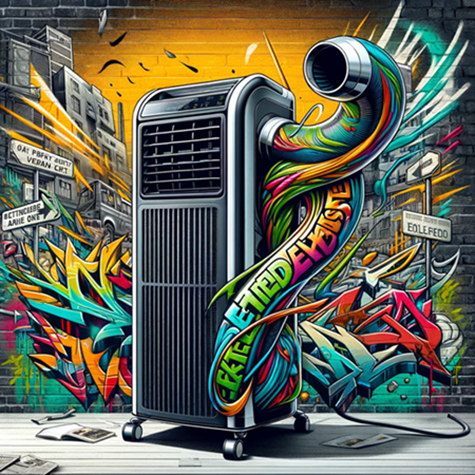How To Extend the Exhaust Hose of a Portable AC

Extending the reach of a portable air conditioner’s (AC) exhaust hose involves connecting multiple hoses together to achieve the desired length. This process, while seemingly straightforward, requires careful consideration of hose diameter, connector compatibility, and maintaining the efficiency of the AC unit. Here is a step-by-step technical guide to extend the exhaust hose of a portable AC unit using pipe connectors.
Materials Required:
- Portable AC Exhaust Hoses: Ensure they match the diameter of the original hose provided with the AC unit.
- Pipe Connectors (Couplers): These should be of the same diameter as the hoses to ensure a snug fit. They are used to join two hoses together.
- Hose Clamps: To secure the connections between hoses and connectors.
- Insulation Tape (Optional): For insulating the connection points to prevent heat leakage.
- Duct Tape (Optional): For additional sealing if needed.
Step 1: Measure and Plan
- Determine Required Length: Measure the distance from the AC unit to the window or vent where the exhaust will be expelled. This determines how much additional hose length is needed.
- Check AC Specifications: Review the manufacturer’s recommendations for maximum hose length to ensure the extended hose does not impair the AC’s efficiency.
Step 2: Select Appropriate Materials
- Hose Diameter: Ensure the additional hoses and connectors have the same diameter as the original hose to maintain airflow consistency.
- Material Compatibility: Choose materials that can withstand the temperature and pressure of the exhaust air.
Step 3: Connecting Hoses
- Prepare the Hoses: If necessary, cut the additional hose to the required length using a sharp knife or cutter.
- Attach the Connector: Slide a hose clamp over one end of the hose, insert the pipe connector into the hose, and then secure it by tightening the hose clamp. Repeat this process for the other side of the connector with the second hose.
- Ensure a Tight Seal: Use insulation tape around the connection points to prevent any air leaks, wrapping it securely around the hose and connector junction.
- Repeat as Necessary: If more than two hoses are being connected, repeat the process until the desired length is achieved.
Step 4: Insulate the Hoses
- Wrap the Connections: Apply insulation tape around each connection point to minimize heat loss and prevent condensation.
- Hose Insulation: Consider insulating the entire length of the extended hose, especially if it runs through areas subject to temperature variations.
Step 5: Testing and Troubleshooting
- Test the Setup: Turn on the AC unit and check for any air leaks at the connection points. Listen for unusual noises that might indicate an issue with airflow.
- Check for Efficiency: Ensure that the AC unit is cooling effectively and that the exhaust is being expelled properly.
- Troubleshoot as Needed: If leaks are detected, tighten the hose clamps further or apply additional duct tape around the seals.
Safety and Maintenance Tips:
- Regular Checks: Periodically inspect the hose connections for leaks or signs of wear.
- Avoid Sharp Bends: Ensure the hose runs in a smooth curve without sharp bends to prevent kinks that could restrict airflow.
Very Important
Consult manufacturer guidelines before undertaking this project, consult the AC unit’s manual or manufacturer’s guidelines regarding hose extensions to avoid voiding warranties or damaging the unit.
The length of the exhaust hose plays a critical role in the air conditioning device’s efficiency and effectiveness. A hose that is excessively long can introduce several problems that negatively impact the performance of the AC unit.
Technical reasons behind the inefficiency caused by an overly extended exhaust hose.
- Increased Airflow Resistance
Fundamental Principle: The efficiency of an air conditioning system is significantly influenced by the airflow through its components. The exhaust hose is responsible for expelling hot air outside the premises.
Technical Impact: An extended exhaust hose increases the distance over which air must travel. This lengthening results in greater air resistance due to frictional forces along the hose’s interior surfaces. As the length of the hose increases, the fan within the AC unit must work harder to push air through the hose. This increased workload can lead to reduced efficiency as the fan consumes more energy to maintain airflow, potentially exceeding the design specifications of the unit.
- Heat Reabsorption
Fundamental Principle: The purpose of the exhaust hose is to remove heat from the interior space. Ideally, this heat is expelled outside efficiently, minimizing the opportunity for it to be reabsorbed.
Technical Impact: With a longer hose, there is a greater surface area through which heat can be lost back into the room or the hose itself, especially if the hose passes through areas not insulated from the indoor environment. This reabsorption of heat counteracts the cooling effect of the AC unit, reducing its overall efficiency.
- Condensation Issues
Fundamental Principle: The air conditioning process involves dehumidification, where moisture is condensed out of the air. This moisture is typically expelled along with the hot air through the exhaust hose.
Technical Impact: In a longer hose, there is a higher likelihood of condensation accumulating within the hose due to temperature differences along its length. This accumulated moisture can create a partial blockage, further increasing airflow resistance and potentially leading to water damage or mold growth within the hose.
- Fan and Compressor Overload
Fundamental Principle: Portable AC units are designed with specific airflow rates in mind, balancing the capabilities of the fan and compressor to achieve optimal cooling performance.
Technical Impact: An overly long exhaust hose can cause the unit’s fan to work harder than intended, which may not only reduce efficiency but also lead to premature wear and tear on both the fan and the compressor. Over time, this can result in increased maintenance costs, reduced lifespan of the unit, and potential failure of these components.
Blogger, amateur photographer and over stressed time poor Dad who loves household gadgets.



